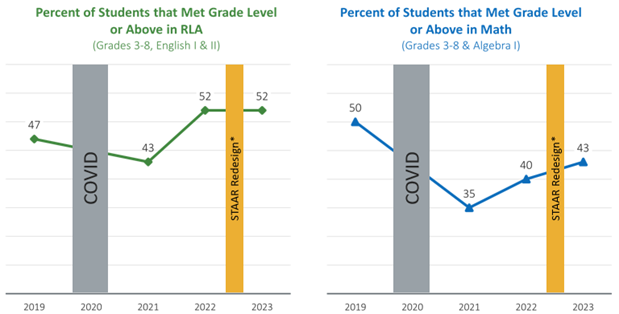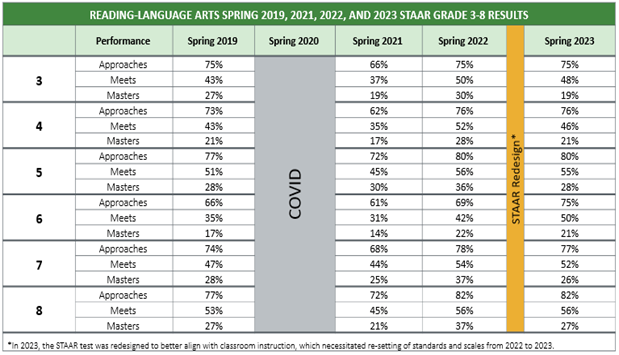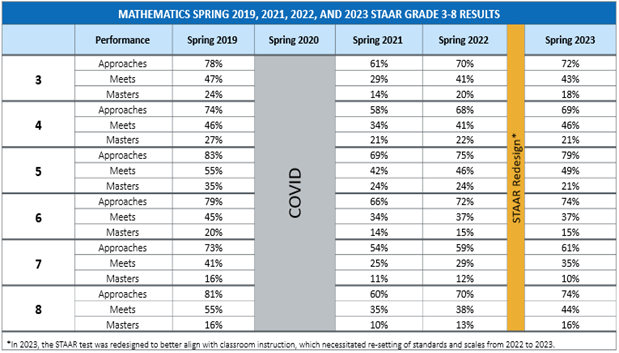TEA Releases Results for 2023 STAAR 3-8 Assessments
AUSTIN, Texas – August 16, 2023 – The Texas Education Agency today released spring 2023 State of Texas Assessments of Academic Readiness (STAAR®) results for students in Grades 3-8. The results include assessments in mathematics and reading-language arts (RLA) in grades 3-8, 5th and 8th grade science, and 8th grade social studies.
This year’s results show reading-language arts proficiency for students in grades 3-8 remains largely unchanged, continuing the level of academic recovery achieved in 2022 coming out of the pandemic. In math, the significant effects of the pandemic still linger, but this year’s results present encouraging signs that the intensive supports offered by Texas public school systems are working. Five of the six tested grade levels saw an increase in the percentage of students that met grade level, while results for Texas 6th graders mirrored 2022 results.
“
Teachers across Texas continue to work with passion and skill to help students learn,” said Texas Education Commissioner, Mike Morath. “This year’s results show the efforts of our educators continue to deliver improved results for students.”
Emergent Bilingual (EB) students showed progress in both mathematics and reading-language arts. In math, 32% of EB students met grade level while 35% met grade level in reading, both of which are at or above all-time high levels of performance for the state. Texas public schools continue to serve one of the largest populations of EB students in the country, with 21% of Texas’ nearly 5.5 million public school students classified as Emergent Bilingual. As part of the Emergent Bilingual Strategic Plan, TEA, in conjunction with its partner agencies, is actively working to increase the number of bilingual certified teachers and dual language one-way and two-way programs to further support these students.
Students receiving special education services continue to show progress, with year-over-year increases in grade level proficiency in grades 3-8 math, 5th and 8th grade science, and 8th grade social studies. Through the provision of more than $1.1 billion in additional annual special education funding over the past seven years, Texas continues to invest heavily to provide critical support for students receiving special education services.
A more detailed, statewide summary of 2023 STAAR 3-8 results is available on TEA’s website.
In addition to releasing results statewide, individual STAAR report cards were also made available to parents across Texas today. Parents can visit TexasAssessment.gov to see the specific STAAR results for their child, how their child answered each question on the test, and specific recommendations to help their child grow academically. Parents can access TexasAssessment.gov by clicking on a link within their district’s parent portal, or by using their child’s unique access code given to them by the school to log directly into the website.
“We recommend parents log in and learn more about their child’s STAAR scores. Being fully informed about their child’s academic progress can help them work with their child’s teacher during the new school year,” Morath said.
In 2023, STAAR assessments were redesigned to look more like how students learn in the classroom. With updates put in place by House Bill 3906 (86R in 2019), TEA engaged in a multi-year, collaborative effort with a wide range of Texas teachers, educator advisory committees, students, parents, and community members to redesign the STAAR.
This year’s STAAR test incorporated items designed more like questions asked in class, emphasized writing, featured more questions that were not multiple-choice items, and was administered online with exceptions made for students requiring paper accommodations. The redesign required standards and scales to be reset, which was done by educator committees this summer. This year’s scores are being issued later in the summer than is typical.
In June 2023, TEA released STAAR EOC Assessment results which showed progress and continued academic recovery following multiple years of pandemic-induced disruption.
STAAR aggregate level data by state, region, district, or campus are available to view and download on the Texas Assessment Analytic Portal.
###





